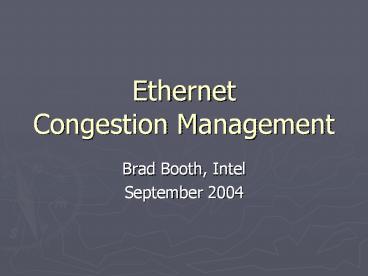Ethernet Congestion Management - PowerPoint PPT Presentation
Title:
Ethernet Congestion Management
Description:
Ethernet Congestion Management Brad Booth, Intel September 2004 Supporters Issue Ethernet not adequate for low latency applications Ethernet frame loss is ... – PowerPoint PPT presentation
Number of Views:32
Avg rating:3.0/5.0
Title: Ethernet Congestion Management
1
EthernetCongestion Management
- Brad Booth, Intel
- September 2004
2
Supporters
3
Issue
- Ethernet not adequate for low latency
applications - Ethernet frame loss is inefficient
- Markets impacted
- Clustering and grid computing (RDMA, iWARP)
- Storage (iSCSI)
- Backplanes (802.3ap, ATCA)
- Video (Video over IP)
- Telecom and voice (VoIP)
- Others?
4
Market Need
- Decreased latency
- Critical for storage and clustering
- Reduces buffer requirements therefore impacts
cost of components - Reduced frame loss
- Important in all network applications
- Prevent oversubscription with no latency impact
- Improves performance of the system
5
Overview
- Oversubscription occurs in MAC Client
- 802.3x could assist, but halts all flows
- Preference is to keep 802.3 simple and rely on
MAC Client to resolve
802.3 MAC Client
MAC Client Service Interface
802.3 MAC
802.3 PHY
6
802.3x
- Pros
- Proactive for oversubscription
- Cons
- Halting all flows is not desirable
- Removes control from upper layer protocols
- Adds latency to all flows
- A feature no one uses
7
MAC Client
- Many varieties of MAC Clients
- 802.1 (bridging)
- TCP/IP, UDP, etc.
- MAC Clients are reactive
- Wait for oversubscription to occur
- Protocols force rate limiting when
oversubscription occurs - Buffers used to prevent transient congestion from
becoming oversubscription
8
The Evil Trade-off
- Buffers vs. frame loss
- Frame loss is considered bad
- MAC Clients can control which frames are lost
- Buffers decrease frame loss, add latency
- Trade-off
- Increase latency and reduce frame loss
- Or, reduce latency and increase frame loss
- No win situation for latency frame loss
sensitive applications
9
Solution
- Provide a means for MAC Client to be proactive
- Decreases need for buffers
- Reduces latency
- How?
- 802.3x was close
- Permit MAC Clients to exchange congestion
information via an 802.3 control messages
10
Value
- Opens up latency and frame loss sensitive markets
to Ethernet - Empower the Ethernet standards with support for
improved congestion control in 802.3 L2 subnets - Increase performance of MAC Clients
- Reduced frame loss decreases re-transmissions
- Decrease cost of Ethernet components
- Reduction in buffer requirements has a direct
correlation to cost of components and systems
11
Recommendation
- Change the Objectives to better align with this
strategy - Thanks to Shimon Muller for his feedback on the
Objectives
12
Current Objectives
13
Current Objectives
14
Proposed Objectives
- Support point-to-point links only
- Specify a mechanism to support the exchange of
congestion control information - Specify a mechanism to limit the rate of
transmitted data - Preserve the MAC/PLS service interfaces
- Preserve the 802.3/Ethernet frame format at the
MAC Client service interface - Support full duplex operation only
15
Thank you!
- Questions?

